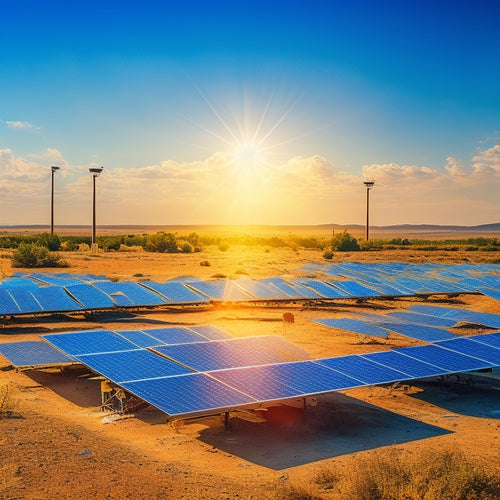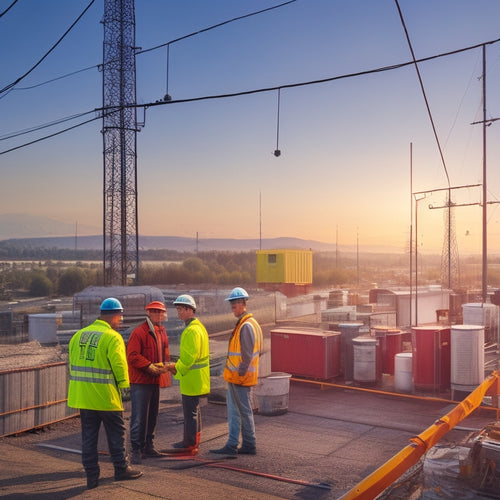
5 Solar Battery Equalization Charging Tips
Share
When maintaining your solar battery bank, you need to understand equalization charging needs, choosing the correct frequency based on battery type and operating conditions. Monitor your battery's state of charge to prevent over/undercharging, and avoid over-equalization charging cycles that can reduce battery lifespan. Implement regular maintenance schedules to identify potential issues and verify charging techniques align with manufacturer's recommendations. By following these essential tips, you'll be well on your way to maximizing your solar battery's performance and lifespan - and there's still more to uncover about optimizing your off-grid energy independence.
Overview
- Identify the recommended equalization voltage and duration based on your solar battery type to prevent over/undercharging.
- Choose the correct equalization frequency depending on your battery type, operating conditions, and charging patterns to maintain optimal health.
- Monitor your battery's state of charge regularly to detect anomalies early and prevent over-equalization charging cycles.
- Avoid over-equalization charging cycles, which can be detrimental to battery health, by setting the charger to recommended voltage and time.
- Implement a regular maintenance schedule to inspect your solar battery system every 3-6 months and identify potential issues before they become major problems.
Understand Equalization Charging Needs
When it comes to maintaining your solar battery bank, equalization charging is an essential step that shouldn't be overlooked.
Regular monitoring of battery state of charge (SOC) and depth of discharge (DOD) prevents overcharging and undercharging setting a discharge limit. You need to understand your battery chemistry to determine the best charging methods.
Flooded lead-acid batteries, for instance, require periodic equalization to prevent sulfation and maintain capacity. You must identify the recommended equalization voltage and duration based on your battery type.
Additionally, consider the charging method used by your solar charge controller, as some may not provide an equalization charge.
Implementing equalizing charging cycles balances individual cell voltages, improving overall battery health and extending lifespan.
Choose Correct Equalization Frequency
Determine the ideal equalization frequency for your solar battery bank by considering factors such as your battery type, operating conditions, and charging patterns.
You'll want to find the sweet spot that balances battery health with energy efficiency. For instance, if you have lead-acid batteries, you may need to equalize every 1-3 months, depending on depth of discharge and charging patterns.
Additionally, maintenance-free designs like Renogy Deep Cycle AGM can reduce the need for frequent equalization.
On the other hand, lithium-ion batteries typically require less frequent equalization due to their more stable battery chemistry.
Aim for a suitable voltage range to prevent overcharging or undercharging, which can reduce battery lifespan.
Monitor Battery State of Charge
Your solar battery bank's state of charge (SOC) is a vital metric to track, as it directly impacts the overall performance and longevity of your off-grid energy system.
You need to monitor your battery's SOC to guarantee it's operating within the ideal range. This involves using battery monitoring systems that provide accurate charge indicators, enabling you to perform state analysis and assess your battery's capacity.
Effective monitoring is essential, as low self-discharge rates reduce energy loss, confirming ideal utilization of stored energy.
Regularly check voltage readings and perform load testing to detect any anomalies. By doing so, you'll be able to identify potential issues before they escalate, assuring your energy system remains reliable and efficient.
Effective battery monitoring is key to maximizing your solar battery's lifespan and maintaining your off-grid independence.
Avoid Over-Equalization Charging Cycles
Equalization charging cycles are vital to maintaining your solar battery bank's health, but overdoing it can be detrimental.
You need to avoid over-equalization charging cycles to prevent overcharging risks that can greatly reduce your battery lifespan. Overcharging can cause excessive heat buildup, corrosion, and plate damage, ultimately leading to battery failure.
When you over-equalize, you're fundamentally forcing your batteries to accept more charge than they need, which can be harmful. To avoid this, set your charger to the recommended equalization voltage and time, and monitor your batteries' state of charge regularly.
Implement Regular Maintenance Schedules
Every three to six months, schedule a thorough inspection of your solar battery bank to identify potential issues before they escalate into major problems.
This proactive approach guarantees your battery maintenance stays on track, preventing unexpected downtime and costly repairs.
During the inspection, check for signs of corrosion, loose connections, and worn-out components.
Verify that your charging techniques are aligned with the manufacturer's recommendations.
Measure the battery's state of charge, voltage, and temperature to detect any anomalies.
Frequently Asked Questions
Can I Use a Regular Charger for Equalization Charging?
When equalizing your solar batteries, you'll need a charger compatible with equalization methods; a regular charger won't cut it, as it may not provide the necessary voltage or current profiles, potentially damaging your batteries.
How Long Does an Equalization Charging Cycle Typically Take?
You'll find that an equalization cycle's duration varies, but typically, it takes 2-4 hours to complete, depending on your battery's state of charge and capacity.
Will Equalization Charging Affect My Solar Panel's Performance?
You might wonder, does equalization charging impact your solar panel's performance? Research suggests it won't, as it only affects the battery; in fact, it enhances solar panel efficiency by ensuring ideal battery maintenance, giving you more energy freedom.
Can I Equalize Charge a Single Battery in a Multi-Battery Bank?
You can equalize charge a single battery in a multi-battery bank, but it's essential to maintain battery balancing; adjusting charging frequency helps prevent overcharging, ensuring ideal performance and extending the lifespan of your entire bank.
Is Equalization Charging Necessary for AGM or Sealed Batteries?
You don't need to equalize charge AGM or sealed batteries, as they're maintenance-free and designed to prevent stratification, ensuring ideal AGM battery maintenance and Sealed battery longevity without the hassle of regular equalization charging rituals.
Ready to Buy
By following these 5 solar battery equalization charging tips, you'll be able to extend the lifespan of your batteries and guarantee peak performance. For instance, a solar farm in California implemented regular equalization charging and saw a 25% increase in energy output. By applying these tips to your own solar battery system, you can achieve similar results and get the most out of your investment.
Related Posts
-

What Happens Without a Charge Controller in Solar Panels
Without a charge controller in your solar panel system, you risk overheating batteries due to overcharging, which can...
-

Essential Hiking Lights for Safety and Fun
When you're hitting the trails, essential hiking lights are vital for safety and fun. A lightweight headlamp offers h...
-

Smart Grid Technology Implementation Challenges
You'll encounter several challenges when implementing smart grid technology, particularly in cost management, scalabi...


